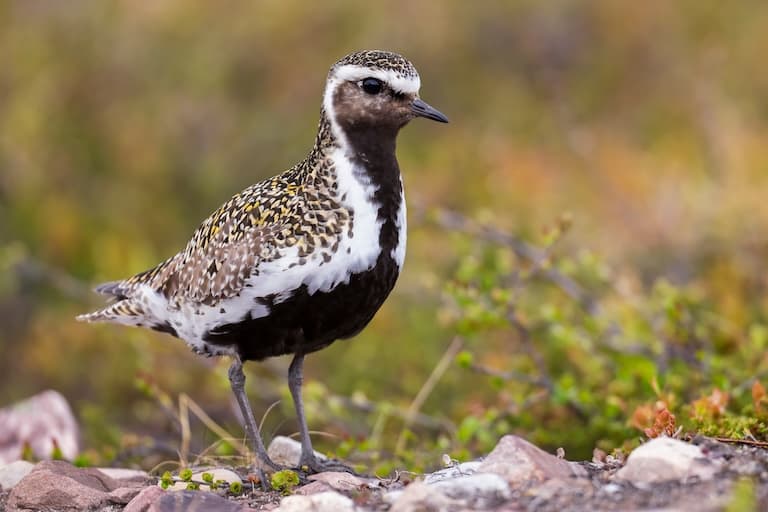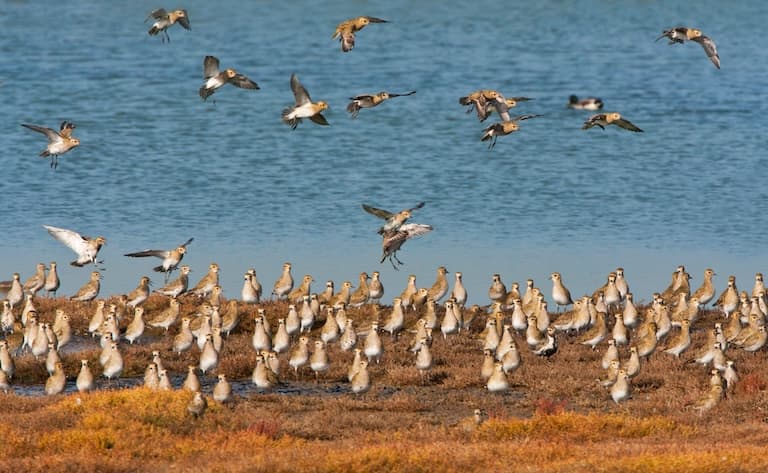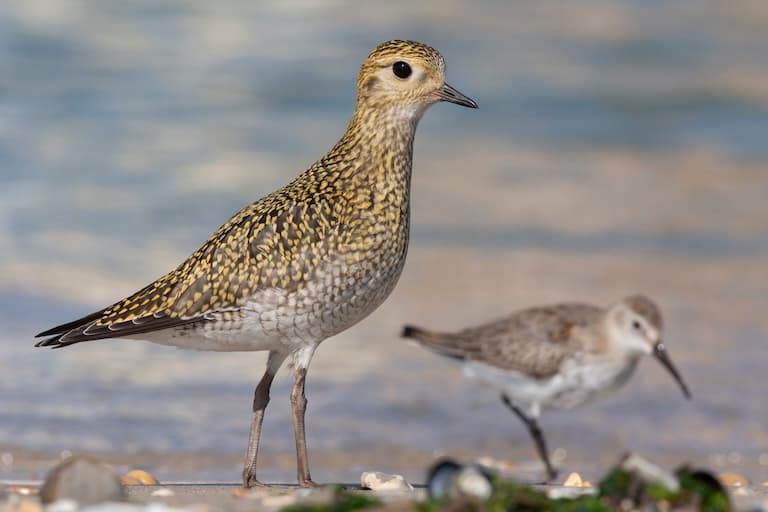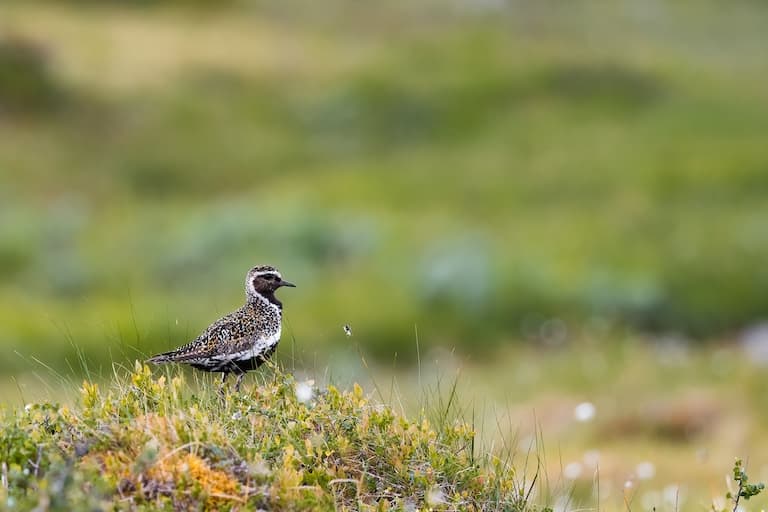European Golden Plover Profile
Let’s face it, Europe has taken in a lot of gold over the years and not all of it was above board.
The British Museum alone holds countless examples from the country’s sticky-fingered legacy, but there is at least some gold that enters the nation voluntarily, and even routinely returns to Africa without the burden of a three-year lease stipulation.
The European golden plover is a cute little migratory waterbird that loves the cool summer tundra of the North but is equally happy overwintering in the Iberian Peninsula and Morocco.

European Golden Plover Facts Overview
| Habitat: | Blanket bogs and tundra for breeding; various sunny beaches for Winter holidays |
| Location: | Northern, Western and Southern Europe, North Africa, and Southwest Asia |
| Lifespan: | Possibly around 10 years (unreliable) |
| Size: | 26-29 cm (8.7 to 11.4 in) long |
| Weight: | 160-280 grams (5.6 to 10 oz) |
| Colour: | Dappled browns and golden yellows |
| Diet: | Mostly insects, also worms, spiders, millipedes, crustaceans and berries |
| Predators: | Foxes, raptors, cats |
| Top Speed: | Unknown |
| No. of Species: | 1 |
| Conservation Status: | Least Concern |
The golden plover has the tremendous privilege of making the most of the European Summer before buggering off to the Med to avoid the Winter.
It is so well known in the North it has inspired popular log books and has a place in Iceland’s traditional heart as the bringer of better weather.
But as soon as the cold returns, they’re off to Africa, Arabia and even Asia, where the food is better and the rain isn’t sideways.
Interesting European Golden Plover Facts
1. Harbingers of rain
The family Charadriidae is where the dotterels, lapwings and plovers hang out. The three names are all pretty classical and no longer correspond to taxonomic groupings so well, so there’s a lot of overlap and they can more or less all be called plovers if you like, at least in common terminology.
To be more precise, these are three groups: the subfamily Vanellinae, which contains the lapwings; the single separate genus Eudromias which has the only dotterel in it; and the Charadriinae subfamily which has 11 genera of plover, one of which is Pluvialis or, the golden plovers.
There are four species in this genus, and some go as far as to give them their own subfamily, but regardless of where you stand on this specific minutia of bird taxonomy, the name comes from the Latin for rain, and this is apparently because they were said to flock in large numbers just before the rains arrived.
The species name of the European golden plover, Pluvialis apricaria, means to bask in the sun, and both of these observations aren’t far off the mark.
2. Harbingers of Spring
These birds like the best of both worlds. They fly all the way up to the Arctic tundra to breed, during the summer, when it’s bright and relatively not cold. They spend summers up in Iceland, where their arrival makes the news as a traditional marker for the arrival of Spring.
These latitudes remove a lot of the competition and provide ample insects and other critters for their chicks to eat, so they are found breeding as far North as Siberia, and rarely farther south than Wales.
But when the temperature begins to change, they are off again, migrating as far South as North Africa, and even down into Egypt and as far East as the Caspian Sea. 1

3. They’re generalists
As long as there is water around, these birds are likely to find something to eat.
While their diet is mostly insects, they’re also happy to feed on any edible invertebrates that cross their paths, such as worms, spiders, and crabs, and will also eat berries for the boost of energy.
Chicks are laid during the period of emergence for marchflies and crane flies, and so these make up a significant portion of the diet of the young birds but as they get older, their diet expands to more or less anything that lives in a swamp.
4. They’re wetland specialists
Breeding plovers love wet moss and tundra, and spend a lot of time in bogs and flooded, stinky forests with swamps and heaths and all the kinds of things where you’d expect to be eaten alive by midges.
When not breeding, they move to freshwater wetlands and flooded grasslands, and forage in the mud and moss there.
They can also be found on the beach, especially if it’s the kind of muddy beach that will suck off your wellies, and will eat crustaceans from rock pools and salt marshes.
They can spend a lot of time in these places, mostly in small numbers or solitary pairs, but when they move, they move in huge numbers.

5. They flock in their tens of thousands
After breeding, the adults will be the first to leave, and the newly-fledged chicks will follow soon after.
While they feed in small patches in the summer, during winter feeding they gather in vast numbers, and when getting ready to head back to their breeding grounds, flocks can number in the tens of thousands. 2
6. They started the Guinness Book of Records
Plovers are known to be fast birds, especially when there’s a shotgun pointed at them, and a dispute between two hunters around just how fast they are is precisely what exposed the glaring lack of documentation on record-holding things.
In 1955, two hunters in Ireland were arguing about whether the grouse or the plover was the fastest and ended up starting a whole book on facts that would become the world’s ultimate log of who can fit the most glue sticks up their noses.
Ironically, there doesn’t seem to be much information on precisely how fast these birds are, only that the plover is the fastest game bird in Europe. Some sources claim up to 80 mph (129 km/h) for the American species, so if that’s true, then it’s certainly believable.
7. They’re on the rise!
The conversion of heathlands to car parks and prefab homes has reduced the range of this species’ breeding grounds considerably, but this hasn’t been enough to stop them.
They’re still hunted in large numbers, too, but these birds prevail!
While certain populations are declining, the species as a whole is considered secure, and their numbers appear to be increasing. Certain management practices such as regulated burning on the moors actually favour the birds, keeping trees down and providing forage and nesting areas.
Europe sees its populations mostly stable or increasing, and there are well over a million adults by all counts, some estimates put them at close to two million. This is very good news for a species that isn’t causing anybody any harm.

European Golden Plover Fact-File Summary
Scientific Classification
| Kingdom: | Animalia |
| Phylum: | Chordata |
| Class: | Aves |
| Order: | Charadriiformes |
| Family: | Charadriidae |
| Genus: | Pluvialis |
| Species: | apricaria |
Fact Sources & References
- Iceland Monitor (2017), “Spring has arrived in Iceland, according to folklore”, mbl.is.
- WWT (2017), “Golden plover migration spectacle”, YouTube.
